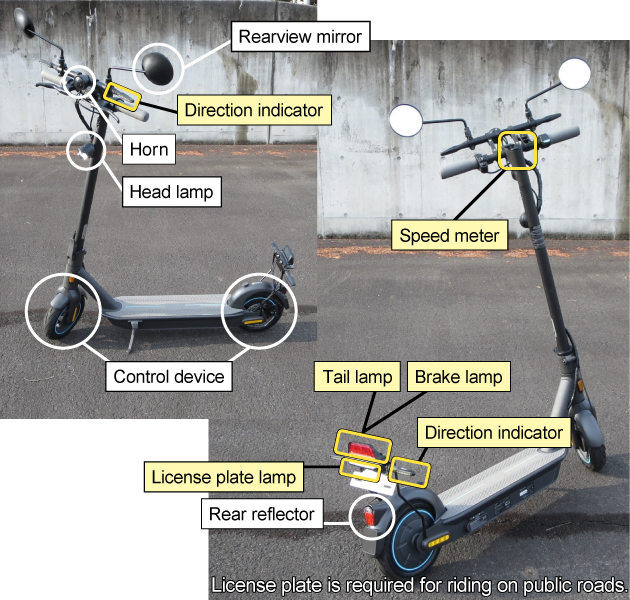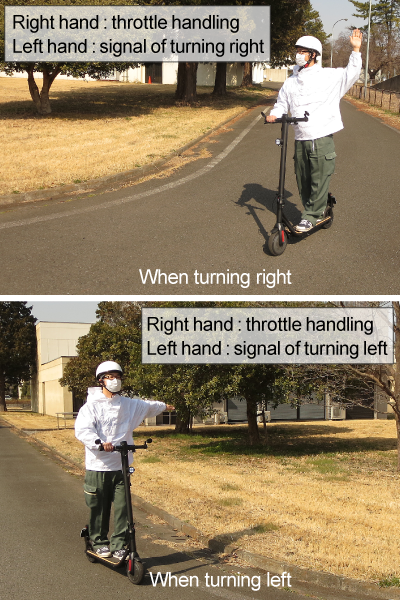E-scooter riding on public road requires driver's license, structure and protective gear in conformity with safety standard
Recently, electric scooters are sold in Japan. An e-scooter is a motorized scooter powered by an electric motor fitted to a board with attached wheels, ridden standing up. Some types of e-scooters are allowed to be ridden on public roads. They have received a lot of attention as a new mobility option. Incidentally, non-motorized scooters are grouped into play equipment and are not allowed to be ridden on public roads regardless of footways or driveways. On the other hand, e-scooters are categorized according to rated power: e-scooters with power of 0.6kW or less are categorized into Class 1 mopeds and are not allowed to be ridden on footways in Japan under the Road Transport Vehicle Act. In order to drive an e-scooter on public roads, the e-scooter needs to be equipped with a brake unit, a head lamp, a rearview mirror, etc. meeting the safety standard of road transport vehicles as well as a license plate. A rider also needs a helmet, a driver's license and automobile third-party liability insurance. There has been an increasing number of reports where some users ride e-scooters not meeting the safety standard of road transport vehicles and do not follow the Road Traffic Act. It is concerned that some consumers do not correctly understand legal requirements for e-scooters and how to ride an e-scooter.
PIO-NET has received 124 e-scooter related inquiries since fiscal 2016. Of the 124 cases, at least 7 cases are accompanied by physical harm and 9 cases are about whether e-scooter riding on public roads is allowed.
In light of the current situation, NCAC confirmed e-scooter riding rules and looked at the structure and protective gear of e-scooters claimed to be drivable on public roads to share correct information on e-scooters.
Photo1: Ten pieces of protective gear required for e-scooter with power of 0.6kW or less

If the maximum speed is less than 20 km/h, the following are not mandated: a license plate lamp, a tail lamp, a brake lamp, a direction indicator and a speed meter.
Test results
Protective gear
- One brand's speed meter indicated a speed slower than the speed measured by photocells. Another brand had a big margin of error.
- All the brands tested were labeled as power 0.6 kW or less.
- All the brands were equipped with protective gear necessary for being ridden on public roads.
- The stopping distance of one brand was longer than the standard stopping distance stipulated by the Road Transport Vehicle Act.
- It was possible to turn off a head lamp of one brand while being ridden, and it appeared to fall short of visibility.
- It appeared that rear reflectors of four brands fell short of reflective performance.
- It appeared that direction indicators of two brands fell short of visibility.
- Horn sound of six brands was not loud enough.
- The rearview mirror size of three brands was not large enough.
- It appeared that the license plate light of one brand fell short of visibility.
- It was possible to turn off a rearview lamp of one brand while being ridden.
- It appeared that brake lamps of two brands gave insufficient illumination.
Labeling and representation
- Instruction manuals of two brands did not give any explanation on public road riding (e.g. necessary items such as a license plate).
- Names of registered companies were not labeled on battery chargers of four brands, although the labeling is required for specified electric appliances including battery chargers.
- Instruction manuals of five brands included precautions to avoid riding in the rain. Other three brands did not indicate precautions to avoid riding in the rain and waterproof performance.
Hand signal while riding e-scooter without direction indicator and brake lamp
- It was difficult to keep balance when riding an e-scooter with one hand giving a direction signal.
Photo 2: Giving a direction signal with one hand while riding

Others
- One brand had very confusing lamps.
Advice for consumers
- E-scooters ridden on public roads (rated power 0.6kW or less) are categorized as Class 1 mopeds. Riders thereof are required to wear a helmet and to have a driver's license based on the Road Traffic Act, automobile third-party liability insurance, etc. The e-scooters need to have structure and protective gear based on the Road Transport Vehicle Act and a license plate.
- When you buy an e-scooter intending to ride it on public roads, be sure to check if protective gear meeting the safety standard is equipped with it and if it is all right to ride it on public roads as is.
- If an e-scooter is not equipped with a direction indicator (maximum speed less than 20 km/h), a rider needs to give a hand signal when turning left or right. When turning right at a busy intersection, dismount the e-scooter and walk on a footway to put safety first.
- While e-scooters are small and convenient, it is not easy to keep balance on an uneven or slippery road surface. Be careful when riding an e-scooter.
- When riding an e-scooter in the dark, wear light colored clothes.
- Basically, e-scooters with power of 0.6 kW or less are categorized as Class 1 mopeds and riders are required to wear a helmet. On the other hand, there are some e-scooters offered by some rental companies based on new business projects under the Industrial Competitiveness Enhancement Act, to which different rules are applied.
Request to businesses
- Protective gear should meet the safety standard of road transport vehicles. If there are any pieces of protective gear not meeting the standard, improve them.
- Some of the brands tested had something wrong with accompanying battery chargers. Follow relevant laws and improve the chargers.
- Continuously inform consumers of necessary items and rules to ride an e-scooter on public roads.
- Install a direction indicator to all the e-scooters drivable on public roads.
- Plainly write what to check before use and how to do regular maintenance in instruction manuals. Provide installation support service, inspection and repair service as well.
Request for cooperation to online shopping mall operators
- For the sake of safe use of e-scooters, keep sellers informed that e-scooters sold in the market should meet the safety standard.
Request to the government
- Raise consumer awareness about characteristics of e-scooters and tips for riding an e-scooter.
- Keep consumers informed about categorization of e-scooters under the Road Traffic Act.
- Keep consumers informed about categorization of e-scooters under the Road Transport Vehicle Act.
- Some companies have manufactured and sold e-scooters with battery chargers not meeting labeling requirements. Please instruct the companies to follow relevant laws when manufacturing, importing and selling e-scooters.
- Keep consumers informed about the difference between e-scooters sold in general and those offered based on new business projects under the Industrial Competitiveness Enhancement Act.
